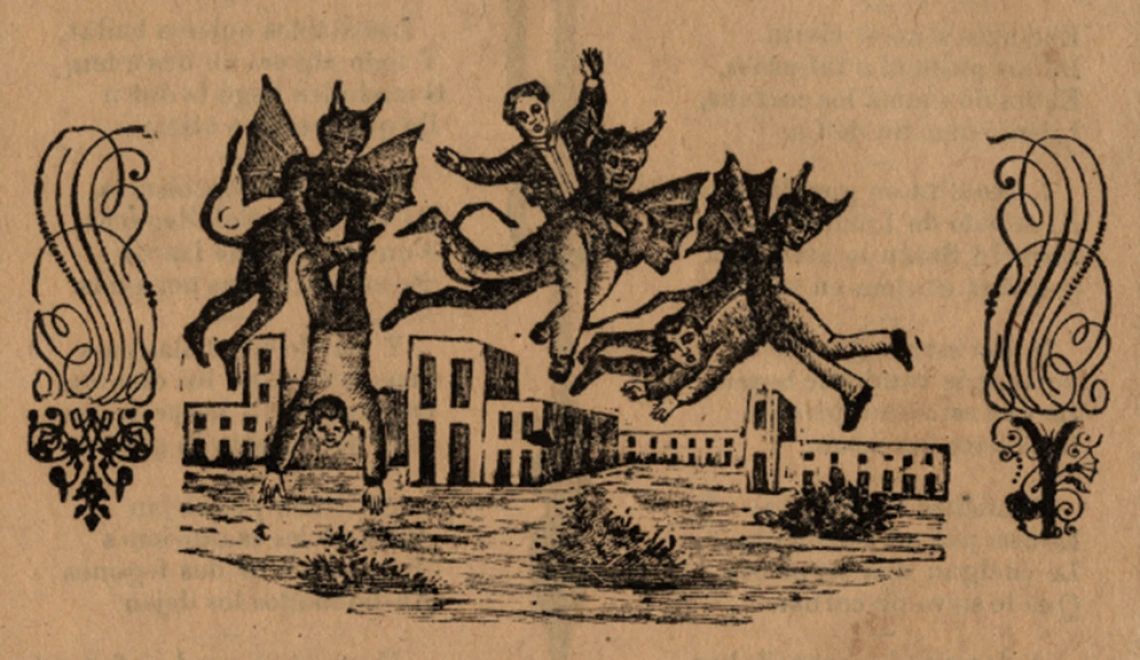Broadsides by Jose Guadalupe Posada

Memorias y recepcion en los profundisimos infiernos del bandido Nicolas Torres (Memory and reception in the bandit Nicolas Torres's deepest hell) by Jose Guadalupe Posada, 1911.
Collection area: Borderlands
Collection dates: 1884-1920
Jose G. Posada worked with the publisher Vanegas Arroyo during the years 1889-1912. This collection is a selection of news sheets from that tumultuous but fascinating period of Mexican history. The gamut of topics covered are: Sensationalized crime accounts, bullfighters accused of rape, politics - including two rare broadsides relating to Fransisco I. Madero, the Mexican Revolution, exploits of particular military leaders, natural disasters, humorous, verse, religious miracles and the like.
Jose Guadalupe Posada was a Mexican political illustrator, printmaker and engraver. He was born February 2, 1852 in Aguascalientes, Mexico to a poor family of nine children. Posada was taught to read, write, and draw by his older brother Cirilo, a country school teacher.
He learned engraving and lithography in Trinidad Pedroso’s Workshop of Popular Graphics. In his late teens Posada began his career as a political cartoonist for El Jicote the local newspaper in Aguascalientes owned by Trinidad Pedroso. Jose G. Posada then moved to the city of Leon, Guanajuato, where he married Maria de Jesus Vela on September 20, 1875. In Leon, Posada and Pedroso ran a small printing and commercial illustration shop which concentrated on commercial and advertising work, illustration of books, and the printing of posters of historical and religious figures. In 1883 Jose G. Posada became a teacher of lithography at the local Preparatory School. In 1888 he moved to Mexico City after a disastrous flood devastated the city of Leon. In 1889 he began working as s a draughtsman at Antonio Vanegas Arroyo’s printing house. In a career that lasted over 40 years he created thousands and thousands of images. Posada is best known for his costumed skeleton characters or Calaveras which he used as a source for his political and social satire. His skeletons have become associated with the Mexican holiday Día de los Muertos, the "Day of the Dead".
Jose G. Posada was largely forgotten by the end of his life. He died penniless and out of favor with local officials on January 20, 1913 in Mexico City. He was buried in an unmarked grave.
Posada's illustrations were brought to a wider fan base in the 1920s by the French artist Jean Charlot who called him the “printmaker to the Mexican people.” His work has gone on to influence many modern day Latin American artists and cartoonist.
A collection guide explains what's in a collection. New to using our collections? Learn how to use a collection guide.
Collection guideAccess this collection
Visit us in person to access materials from this collection. Our materials are one-of-a-kind and require special care, so they can’t be checked out or taken home.
How to cite
Learn how to cite and use materials from Special Collections in your research.
